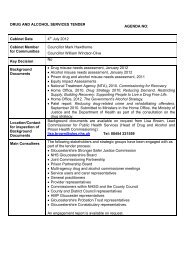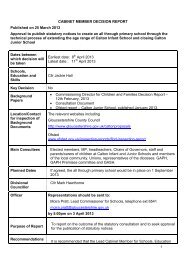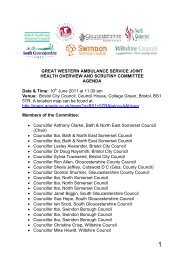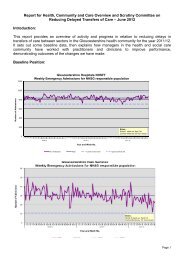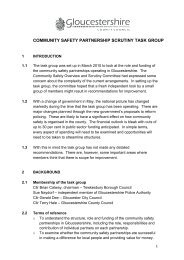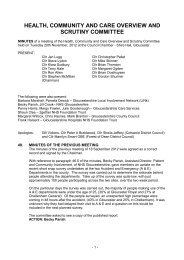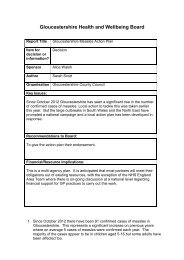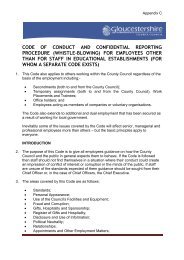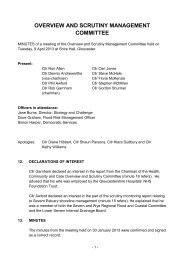Agenda item 4 - MTFS (Final) Cab 070213 , item 9. PDF 1 MB
Agenda item 4 - MTFS (Final) Cab 070213 , item 9. PDF 1 MB
Agenda item 4 - MTFS (Final) Cab 070213 , item 9. PDF 1 MB
You also want an ePaper? Increase the reach of your titles
YUMPU automatically turns print PDFs into web optimized ePapers that Google loves.
These additional savings will be achieved by reducing uncommitted commissioning and<br />
contingency budgets, renegotiating contracts, reducing capacity for school intervention as schools<br />
convert to academies, changes in funding for vulnerable pupils (already subject of <strong>Cab</strong>inet<br />
decisions) and deleting staff posts held vacant.<br />
These proposals are based on the following principles:<br />
1. Spending reduce in areas subject to government grant reductions or changes<br />
2. The capacity to intervene early wherever possible should be protected<br />
3. The council must be able to discharge its core responsibilities in relation to vulnerable<br />
children in the education system and social care<br />
4. Areas which have already been subject to significant budget reductions to be protected<br />
wherever possible for 2013/14.<br />
Needs Analysis<br />
There are 129,757 children and young people under 19 in Gloucestershire, 22% of the population.<br />
The majority do well at school (62.5% achieved 5 A* - C at GCSE in 2010-11); they report that<br />
they are confident or quite confident about the future (88% from the Online pupil survey OPS<br />
2012); more children are ‘feeling safer from crime‘, though a just over a quarter still feel unsafe<br />
from crime (OPS 2012). A significant minority do not have the same positive life chances as their<br />
peers – the gap in achieving 5 A* - C including English and Maths at GCSE, between children<br />
eligible for free school meals and those with SEN, and the rest, has marginally improved but is<br />
still a larger than statistical neighbours and England (24,137 children).<br />
For the most vulnerable children there is a need to focus our efforts e.g. only 8% of LAC achieved<br />
5 A* - C GCSEs including English and Maths for the academic year 2011-12; LAC in education,<br />
employment and Training EET levels are fairly stable but at the low level of 69% at the end of<br />
September 2012; 442 children were subject to a CP plan at the end of November 2012, of which<br />
46% (204) were under 5yrs and, for them, the most common issues are long term neglect<br />
combined with parental substance/ alcohol misuse and domestic abuse. Secondary children report<br />
having seen, heard or been a victim of domestic abuse quite often or most days (6% OPS 2012).<br />
Strategic Direction<br />
Given the financial context and identified needs there is a continuing need to reshape our<br />
response to some of our most troubled families whilst ensuring that universal services continue to<br />
be of high quality. This will increasingly involve partnerships with local communities and partners<br />
encouraging them to meet the needs of families. Demand needs to be managed so that council<br />
resources and efforts are targeted effectively on identifying and working with vulnerable families at<br />
the earliest opportunity and strong, quality specialist interventions where necessary.<br />
The Children and Young People’s Plan is part of the developing local Health and Well Being<br />
Strategy, this is based on a full needs analysis and clearly targets the most vulnerable children<br />
and their families. The priority groups for partnership action will continue to be those who need<br />
safeguarding, LAC, children in poverty, disabled children and young people; change programmes<br />
need to include the development of an ‘early help’ offer, ensuring there is a good range of targeted<br />
interventions and high quality specialist support for the most vulnerable groups. All of this will<br />
require workforce development across the sector to ensure that families receive a joined up<br />
service. The Gloucestershire Children’s Safeguarding Board will play a key role in harnessing<br />
effort across agencies, holding all partners to account and ensuring a strong quality assurance<br />
process is in place.<br />
27





